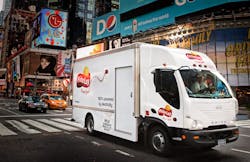An effort by the U.S. Department of Defense (DOD) to test “vehicle-to-grid” or “V2G” technology on all-electric trucks starting this year may breathe new life into the cost-saving potentials for such equipment, according to Bryan Hansel, CEO for Smith Electric Vehicle Corp.
“This technology potentially creates another revenue stream for all-electric trucks, which would significantly improve their update ROI [return on investment],” he told Fleet Owner, noting that Smith has now built over 700 of its all-electric Newton and Edison models to date. “This could change the face of the medium-duty potential for all-electric trucks because any fleet – not just the military’s – could attach such [V2G] revenue to their bottom line.”
Back in January, the DOD announced it would spend $20 million on a fleet of electric vehicles (EVs) – cars and trucks alike – that incorporated V2G technology so they could both import and export energy, thus offsetting their higher cost relative to conventional petroleum-powered equipment.
At the time, Camron Gorguinpour – special assistant to the assistant secretary of the Air Force for installations, environment and logistics – said the DOD expected to lease as many as 500 EVs at six different installations in 2013, with Los Angeles Air Force Base envisioned to be the first federal facility to replace everything from passenger sedans to shuttle buses with all-electric models.
The DOD said it expected not only to use all-electric cars and trucks to fulfill a variety of daily service tasks but also to use them when not in operation as “re-supply points” providing stability to stressed electrical grids at times of peak demand and, in the process, generating a financial return for the government.
“It’s about being able to deliver electricity on demand. It will be a sizable amount of power when all of the vehicles are aggregated together,” Gorguinpour said. “The three main criteria we’re focused on are reducing fleet expense, enhancing mission capabilities and meeting our energy efficiency goals [and what] we have identified is a path forward that will allow us to bring electric vehicles into our fleet that are less costly than conventional vehicles.”
Smith’s Hansel told Fleet Owner that several of the company’s Newton model medium-duty electric trucks are expected to be upfitted with V2G technology in order to allow for what he called “bidirectional” flow of energy.
“Typically, all-electric trucks feature a ‘unidirectional’ battery system, so energy can only flow one way -- to recharge their batteries,” he explained. “A bidirectional system allows the batteries to recharge and to discharge energy to the electrical grid to which they are plugged into.”
He noted that electric utilities typically must invest in what he termed “peaker plants” that act as energy storage systems to help “stabilize” energy levels during peak demand periods. However, using the battery systems of off-duty electric vehicles – cars and trucks alike – could alleviate the need for “peaker plants,” while allowing EV owners to generate revenue even when their equipment is not in operation.
“Just 10 or our trucks combined can offer one megawatt of power – that’s a lot,” Hansel said. “And ‘stabilizing’ energy levels doesn’t require much power. This isn’t a case where the truck batteries would be drained; on the contrary, under the terms of such agreements, whatever power is used must be replaced, so the vehicles would be at full-charge when their duty cycle begins.”
Though still in its infancy to a degree,V2G technology is being tested widely in both the private and public sectors. For example, the University of Delaware and NRG Energy began work in September 2011 to commercialize V2G technology, and in February last year its V2G system became what’s known as an “official participant” with PJM Interconnection in the “frequency regulation” market.
“Frequency regulation” is the term used to describe the process of “balancing” electricial supply and demand on the grid second-by-second, noted Denise Wilson, NRG’s executive VP, in a statement last year. To date, the University/NRG project has been selling power services from a fleet of EVs to PJM, a regional transmission organization that coordinates the movement of wholesale electricity in a territory comprised of 60 million people within the 13 Mid-Atlantic states.
“This demonstrates that EVs can provide both mobility and stationary power while helping making the grid more resilient and ultimately generating revenue for electric vehicle owners,” Wilson stressed. “For grid operators, this [V2G] technology serves as an innovative new approach to energy storage. It has the potential to balance the power provided by intermittent renewable resources such as wind and solar. Energy storage, such as large-scale batteries or those in a fleet of vehicles, can take the wind’s power generated at night and store it to use when demand is higher.”
About the Author
Sean Kilcarr
Editor in Chief
Sean Kilcarr is a former longtime FleetOwner senior editor who wrote for the publication from 2000 to 2018. He served as editor-in-chief from 2017 to 2018.
